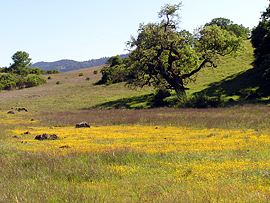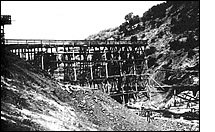|
Welcome
 Jasper Ridge Biological Preserve (JRBP) is located near Stanford
University's campus in the eastern foothills of the Santa Cruz Mountains. The Preserve encompasses remarkable
geologic, topographic, and biotic diversity
within its 481 hectares (1,189 acres) and provides a natural
laboratory for researchers from all over the world, educational experiences
to students and docent-led visitors, and refuge to native plants and
animals.
Jasper Ridge Biological Preserve (JRBP) is located near Stanford
University's campus in the eastern foothills of the Santa Cruz Mountains. The Preserve encompasses remarkable
geologic, topographic, and biotic diversity
within its 481 hectares (1,189 acres) and provides a natural
laboratory for researchers from all over the world, educational experiences
to students and docent-led visitors, and refuge to native plants and
animals.
The careful management of the Preserve's ecosystems in as natural a state as possible allows scientists to quantify changes observed in similar ecosystems affected by a range of human impacts. In addition to facilitating first-rate research, this highly accessible field station provides undergraduate educational experiences and plays an active role in educating the general public. Research
The area now included within the Jasper Ridge Biological Preserve has been used for scientific studies since the opening years of Stanford University. Since that time, the scientific contributions of JRBP have reflected the capacity of scientists and students at Stanford and other institutions to envision, conduct, and interpret groundbreaking research involving a range of academic disciplines. Many current studies draw on this legacy of research, while others address new questions and problems. In total, 165 dissertations and theses have involved research at JRBP, and since 1965, 335 publications have reported research at JRBP. Students have submitted over 400 papers resulting from studies at JRBP.
 The Preserve is widely recognized as the site of discoveries that have been important both to fundamental scientific questions and to society. For example, Professor Paul Ehrlich's discoveries about Bay checkerspot butterflies demonstrated the unique value of long-term research in ecology, and helped foster federal programs to fund such studies.
The importance of long-term research and monitoring is now widely accepted. A number of scientific publications resulting from research at JRBP discovered ecological patterns so significant they stimulated hundreds of related studies. Many of these papers by Professors Christopher Field and Harold Mooney established principles that are the foundation of the largest research program now at JRBP, a study of ecosystem responses to a suite of environmental changes that are occurring globally. A long-term monitoring project by Professor Deborah Gordon's lab has mapped the invasion of Argentine ants and used "before and after" comparisons of ecological communities in the path of the invasion to better understand the ants' impacts.
These studies and others demonstrate the intrinsic connection between JRBP's missions in research and conservation.
The Preserve is widely recognized as the site of discoveries that have been important both to fundamental scientific questions and to society. For example, Professor Paul Ehrlich's discoveries about Bay checkerspot butterflies demonstrated the unique value of long-term research in ecology, and helped foster federal programs to fund such studies.
The importance of long-term research and monitoring is now widely accepted. A number of scientific publications resulting from research at JRBP discovered ecological patterns so significant they stimulated hundreds of related studies. Many of these papers by Professors Christopher Field and Harold Mooney established principles that are the foundation of the largest research program now at JRBP, a study of ecosystem responses to a suite of environmental changes that are occurring globally. A long-term monitoring project by Professor Deborah Gordon's lab has mapped the invasion of Argentine ants and used "before and after" comparisons of ecological communities in the path of the invasion to better understand the ants' impacts.
These studies and others demonstrate the intrinsic connection between JRBP's missions in research and conservation.
Jasper Ridge also contributes broadly in that it is open to any qualified investigator who proposes studies that are consistent with the Preserve's mission of research, education, and long-term resource protection. Proposed studies are evaluated on whether they:
Education
 In academic year 2002-03, the new Jean Lane Environmental Education classrooms of the Leslie Shao-Ming Sun Field Station housed a stimulating and diverse range of classes, lectures, workshops, and discussions. Stanford University classes included Core Experimental Laboratory for Ecology (Biology 44Y), Field Studies in Earth Systems (Earth Systems 189), Botany (Biology 120), Jasper Ridge Docent Training (Biology 96 A/B), as well as the Quest Scholars Program. Additionally, workshop classes were held quarterly in collaboration with the Stanford Teacher Education Program and the Stanford Ecology and Environmental Sciences retreat filled the building with students and faculty in March of 2003.
In academic year 2002-03, the new Jean Lane Environmental Education classrooms of the Leslie Shao-Ming Sun Field Station housed a stimulating and diverse range of classes, lectures, workshops, and discussions. Stanford University classes included Core Experimental Laboratory for Ecology (Biology 44Y), Field Studies in Earth Systems (Earth Systems 189), Botany (Biology 120), Jasper Ridge Docent Training (Biology 96 A/B), as well as the Quest Scholars Program. Additionally, workshop classes were held quarterly in collaboration with the Stanford Teacher Education Program and the Stanford Ecology and Environmental Sciences retreat filled the building with students and faculty in March of 2003.
During spring quarter, the Eastside College Preparatory School's Field Studies class collected and studied their ecosystem data with the help of Stanford undergraduates, and in June, Jasper Ridge hosted a weeklong field trip for Ecological Society of America students representing colleges and universities from throughout the United States. Jasper Ridge is a unique resource that supports Stanford's field sciences. Faculty and students rely on Jasper Ridge Biological Preserve to provide an environment essential to their research and teaching. In any given year, 15-25 Stanford courses accounting for over 2,000 undergraduate visits make use of the Preserve. In addition, 5-10 non-Stanford university classes accounting for another 100-300 students visit JRBP each year. JRBP also provides educational opportunities for 1,500-2,000 K-6 children, mostly through the Environmental Volunteers. See our Annual Report for details. Tours of the Preserve are conducted from October 1 through May 31 on Fridays, Saturdays and Sundays at 10:00 am and 2:00 pm. During the spring wildflower season (March and April) tours will be scheduled Thursday through Sunday at 10:00 am and 2:00 pm. Tours must be scheduled well in advance. Children under 14 are not permitted. Tours typically involve 2 to 2.5 hours of walking on hilly terrain. There are a limited number of tours conducted each year and priority goes to tours that are most closely aligned with the Preserve's mission "to contribute to the understanding of the Earth's natural systems through research, education, and protection of the Preserve's resources." Facilities
 The Leslie Shao-ming Sun Field Station, Jasper Ridge Biological Preserve's 9,800 square foot research and education facility houses a research laboratory, two classrooms, a reference library, a herbarium, and staff offices. The new facility, completed in June of 2002, was designed to minimize its environmental footprint and serve as an educational tool to demonstrate principles of sustainability and energy efficiency. In 2003, the Sun Field Station was awarded the first Sustainable San Mateo County Green Building Award.
The Leslie Shao-ming Sun Field Station, Jasper Ridge Biological Preserve's 9,800 square foot research and education facility houses a research laboratory, two classrooms, a reference library, a herbarium, and staff offices. The new facility, completed in June of 2002, was designed to minimize its environmental footprint and serve as an educational tool to demonstrate principles of sustainability and energy efficiency. In 2003, the Sun Field Station was awarded the first Sustainable San Mateo County Green Building Award.
The research laboratory contains lab benches, storage cabinets, water, a freezer, a refrigerator, a walk-in cold room, computer facilities, and basic laboratory equipment such as drying ovens and balances. The research lab also contains a Geographic Information System (GIS) and Global Positioning System (GPS) lab that includes two workstations and three Trimble GPS units. The Jean Lane Environmental Education Classrooms have bench space, storage cabinets, audio/visual equipment, and a number of teaching collections and interpretive displays. The education library contains over 1000 titles and extensive photographic collections of plants, birds, and insects. Also, the publications library contains over 1000 papers and projects conducted at the Preserve by students, docents, and researchers. The Oakmead Herbarium contains John Thomas' teaching collection of 5,000 to 6,000 mounted specimens, a collection of California lichens, and two compound microscopes. Landuse History
Jasper Ridge Biological Preserve has a long history of human influence. The Preserve is located in the middle elevations of the San Francisquito Creek watershed, several areas of which have been excavated by Stanford archaeologists. Lower portions of the watershed outside JRBP include occupation sites of the local Native Americans, known as the Muwekma-Ohlone, that date to more than 5,000 years ago; permanent year-round villages were established within JRBP that date to a later period, between 600 and 2000 years ago. The Muwekma-Ohlone economy before European contact included hunting, fishing, harvesting of shellfish in the San Francisco Bay and on the Pacific coast as well as extensive collection of plant foods and materials and trade with neighboring tribes for highly prized raw materials and craft items. The Muwekma-Ohlone were "complex hunter-gatherers" living in permanent settlements at a fairly high population density; this level of land use required extensive management of animal and plant resources, for example the use of fire to clear brush, encourage the growth of seed-bearing plants, and improve forage for game animals.
The arrival of Spanish soldiers and missionaries in the late 18th century disrupted the Muwekma-Ohlone community, and the closing of mission properties after the U.S. annexation of California in 1846 scattered the remaining descendants into isolated "rancheria" settlements. Stanford archaelogists have collaborated closely with Muwekma-Ohlone descendants since the founding of the university in the 1890s. The Muwekma-Ohlone Tribe continues to participate in educational activities at Stanford University and JRBP.  Demand for lumber for missions and towns in the 1850's led to the establishment of sawmills adjacent to San Francisquito Creek and other nearby creeks. A small town, Searsville, sprang up nearby, but was short-lived, condemned in 1879 to make way for the construction of Searsville Dam. Most redwoods in the area of the present Preserve were cut by the 1870's. Since then, the 389 ha central body of JRBP has remained largely undisturbed, except for grazing, which ended in 1960.
Demand for lumber for missions and towns in the 1850's led to the establishment of sawmills adjacent to San Francisquito Creek and other nearby creeks. A small town, Searsville, sprang up nearby, but was short-lived, condemned in 1879 to make way for the construction of Searsville Dam. Most redwoods in the area of the present Preserve were cut by the 1870's. Since then, the 389 ha central body of JRBP has remained largely undisturbed, except for grazing, which ended in 1960.
In the 1890's a local water company erected a dam below the confluence of four tributaries of San Francisquito Creek, forming Searsville Lake. The dam, lake, and adjacent lands were purchased by Stanford University between 1892 and 1926, completing the University's holdings of the present Preserve. For the next 50 years, the Searsville Lake area was managed by leaseholders as a recreational area, while scientific use intensified in the central portion of the Preserve. Conflicts between the two uses developed and from 1956 to 1976, the Stanford Board of Trustees progressively afforded more protection to JRBP lands. In 1973 the Stanford Board of Trustees formally designated JRBP as a biological preserve and terminated the recreational activities at Searsville Lake in 1975. |
|||||||||||||||||||||||||||||||||||||||||||||||||||||||||||||||||||||||||||||||||||||||||||||||||||||||||||||||||||||||||||||||||||
| Terms of Use | Webmaster | © 1998 - 2015 Jasper Ridge Biological Preserve of Stanford University jrbp.stanford.edu | |